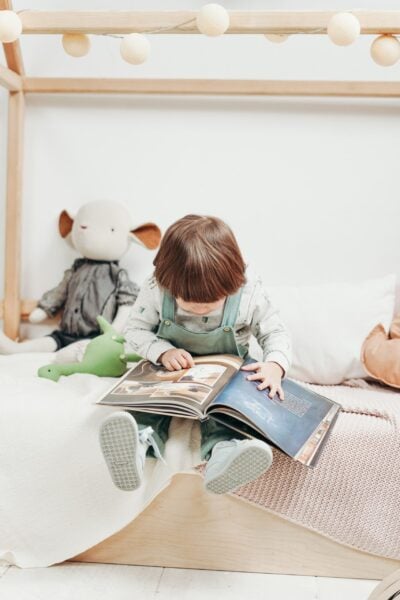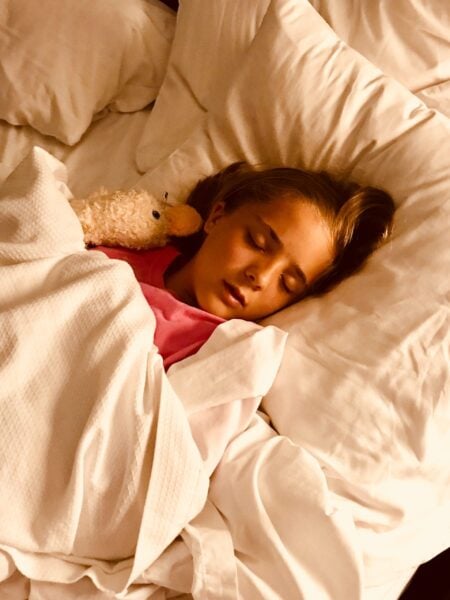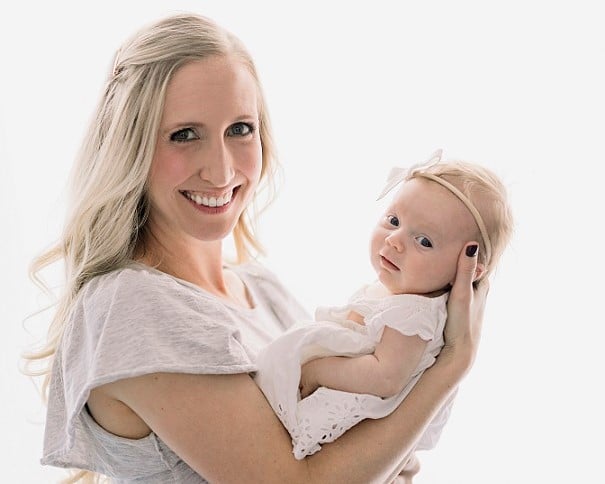Sleep regressions are caused by many different things, such as developmental milestones, illness, when it’s time to drop a nap, etc. But a lesser-known factor that can cause a sleep regression is separation anxiety.
Separation anxiety and the sleep regression that can come with it are totally natural, especially during the peak of toddlerhood. It’s right at this time that their incredible imagination is developing, which means lots of creative play, silliness, and even new and scary fears.
It’s common for these fears to come to life around bedtime and even in the middle of the night. Not to fear! There are plenty of things to try with your little one to help them get through this regression and the anxiety they face.

In this blog post, I’m going to talk about:
Can separation anxiety cause sleep regression?
How can I manage separation anxiety at bedtime?
What do I do when my toddler’s separation anxiety strikes in the middle of the night?
Can separation anxiety cause sleep regression?
We often talk about sleep regressions at specific times/month-markers of your baby’s first few years. You know, sleep regressions like the dreaded one at 4 months..and then sometimes at 6 months, 8 months, and so on.
It’s important to note that sleep regressions happen all the time, and separation anxiety can be the cause.
While a sleep regression from separation anxiety can happen at different times, it’s extremely common around 18 months. Your baby is transforming into a toddler which can be overwhelming for them. The best you can do for them is help get them the sleep they need by creating consistent boundaries AND staying responsive and a being source of comfort.
Here are two things to remember for the sleep regression of separation anxiety:
1. Prevent Overtiredness
Preventing overtiredness is the key to surviving any sleep regression. For toddlers and almost-toddlers, this means:
- Continue to offer their nap. Most toddlers still need a nap until around 3 years old
- On days when they don’t nap bump bedtime earlier to prevent overtiredness
The key is to continue to provide time and space for them to sleep, even when they are protesting bedtime and their imagination is running wild right before bedtime.
2. Stay Consistent
In the realm of sleep anxiety, I find this is where having a bedtime routine is the best. There’s comfort in routine, so having structure around bedtime can provide reassurance that everything is running smoothly, according to plan, and they (and you) are going to be ok.
The overarching question is, “How do we keep a boundary to avoid undesirable habits while staying responsive to their need for comfort?”
This is where tuning in comes into play. Being scared is when they DO need you…protesting sleep and throwing a fit is a different story. We want to tune into our children and learn their wants vs their needs.
That being said, toddlers are still VERY new to this dealing-with-emotions thing. They need our help in identifying and regulating those big and new emotional needs! Give them the comfort they need during this phase while also instilling confidence in them that they’ve got this and you will always be there for them!

How can I manage separation anxiety at bedtime?
During the sleep regression of separation anxiety, the trick is finding outlets to comfort them without having your physical presence all throughout the night. We want tools they can use that represent you and the comfort you give…ultimately, we want them to learn how to self-soothe!
The great news is that toddlers are just getting SO good at using their imagination. Use this to your advantage, and help them really feel your comfort through different objects and tools in their room.
Here are some ideas you can implement before your little one is asleep to help them feel comforted while keeping a consistent boundary:
-
Set the stage during the day
-
- Throughout the day, talk about how mommy and/or daddy always come back. Help them learn that you are there for them, even if you are not physically beside them at night.
- There’s a great Daniel Tiger episode that models this perfectly! Click here to watch it.
-
Give them a Piece of You
- One creative strategy is to sleep in the same shirt for a few nights and then give them that shirt to sleep with. Your smell is comforting!
- You could also attach a special meaning to other objects, like a stuffy. Give your little one a special bear or blanket and make up a soothing story about how it can comfort them to go along with it.
-
Hang Family Pictures
- Having a picture of you framed and on their nightstand can serve as a sweet reminder of your loving face.
What do I do when my toddler’s separation anxiety strikes in the middle of the night?

So what do you do when your toddler comes into your room sobbing, shaking from worry, and missing you?
Sometimes all it takes is a quick snuggle, being tucked in, and a kiss on the forehead for them to get back to bed. Other times, we might actually want to climb into bed for a second to help them calm down.
I recommend spending anywhere from 30 seconds to 5 minutes with them. From there, you can encourage them to sing a lullaby, think about happy memories, etc. on their own.
One creative idea I have found that works well is recording yourself singing or telling a story and then playing it through a Bluetooth speaker in their bedroom. What’s awesome about this idea is they often can push the buttons themselves to play your recording!
Try different strategies/comfort tools for a few days to find what helps. Remember, the sleep regression from separation anxiety is just a phase! These phases can be so tough and feel like they’ll never end…“This is where a consult can be SO helpful! We can work collaboratively with you to create an individualized sleep plan for your toddler. We will talk about meeting their emotional needs in a low-impact way and make a plan to get independent sleep back on track.
Recap on Sleep Regression from Separation Anxiety

The toddler stage is a whole new world in which we navigate our tiny human’s rapidly developing imaginations. While this is just a phase, remembering to be responsive and supportive of their needs without causing undesirable habits is the goal.
You can have fun and be creative with different strategies to make the process engaging for your toddler which will greatly diminish those “power struggles”.
You do NOT have to go through this sleep regression and separation anxiety phase alone! Grab a consultation and we will be right there every step of the way, supporting you in a way that works best for BOTH of you.



0 Comments